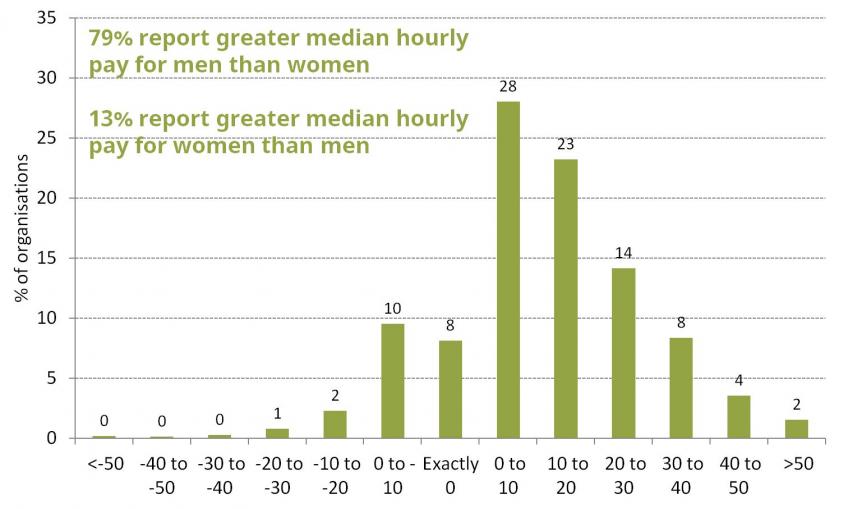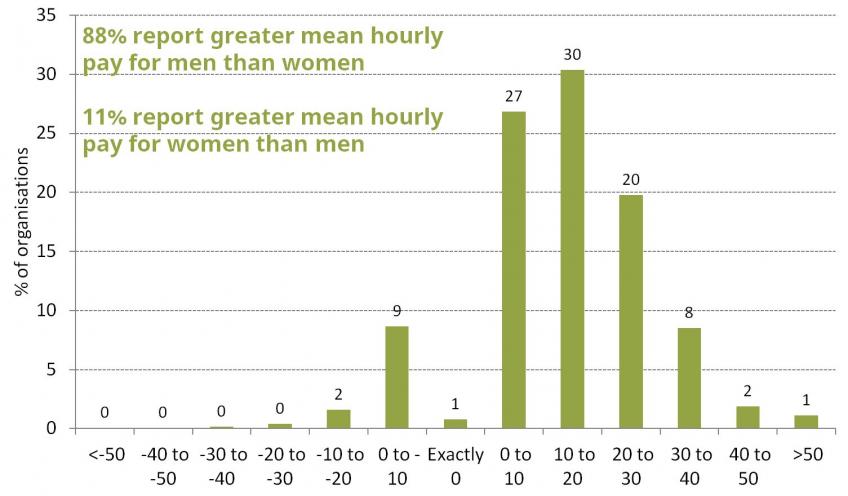Tomorrow is the final deadline for organisations with 250 or more employees to fulfil the new gender pay reporting requirements. These requirements include providing information on the percentage gap between both mean and median hourly wages of men and women. Additional information has to be provided on the proportion of men and women receiving bonuses and on the gender breakdown of each quartile of the organisation’s hourly pay structure.
These data could help shed useful light and attention on an important issue. IFS researchers have recently shown the gender wage gap has not fallen very much at all in the last fifteen years: it was 23% in 2003 and is now 20%. And among graduates the gender wage gap has not fallen at all over this period. The research also shows that some, but not all, of the gender wage gap is explained by the fact that after having children women are much more likely than men to work part-time, and part-time work is associated with little or no subsequent progression in hourly wages. This is particularly important for graduates for whom full-time experience typically delivers considerable wage growth.
The greater prevalence of part-time work among women means that the government is wise to ask for reporting of hourly wages rather than annual earnings. Employers offering very family-friendly employment terms are likely to employ a greater fraction of women part-time and therefore would have large differences in average annual earnings even if there were no difference in hourly wages.
Requiring large employers to provide information on their gender wage gap could therefore be a useful step. There should be benefits from both transparency and greater awareness of the issue. Over time the data will allow the monitoring of trends in gender pay gaps in different industries.
The data can be downloaded from the Government’s gender pay gap service here. At the time of writing (7pm on Monday 2 April 2018) information was available from 7,556 organisations. The Government’s impact assessment estimated that around 8,000 private-sector and voluntary organisations would be required to provide information. And the obligation applies to public-sector employers too.
As ever, however, the statistics are limited and need to be interpreted with care. The IFS research cited above shows that part of the gender wage gap results from women on average having less experience of being in paid work full-time than men. The cause of – and therefore the appropriate response by policymakers to – this part of the gender wage gap could be very different to, for example, the part of the gender wage gap that exists prior to the arrival of a first child. And even if men and women were on average paid the same, one would expect to see some variation across employers. For some employers we should not be surprised to see considerable gender pay gaps, and to see a much bigger difference in the mean gap than the median gap. For example five organisations are currently reporting that their mean gender wage gap is 80 percentage points or more larger than their median gender wage gap and all five are English Premier League football clubs. In addition, within-organisation gender pay gaps may miss important causes of the wider gender wage gap: namely differences between men and women in the kinds of organisations that they work for. There is evidence from elsewhere that part of the gender wage gap is explained by men being more likely to work for more productive, higher paying, firms.
A careful examination of the data suggests some reporting errors. As the Financial Times has highlighted there is a greater prevalence of employers reporting a pay gap of exactly zero, at both the mean and the median, than would be expected. Currently this is true of 45 reports. There are also some other entries that look incorrect. For example one organisation reports that almost everyone in the bottom half of its pay structure (at least 99.8%) is female whereas the top half comprises both men and women – and despite this it reports that it its gap in median hourly pay is precisely zero!
The full distribution of reported gender pay gaps from the data so far is shown in Figure 1 (median) and Figure 2 (mean). Most organisations have a positive gender wage gap – that is on average men receive more per hour of work than women. This is true of 79% of organisations when considering median pay and 88% of organisations when considering mean pay. The mean gap is generally greater than the median gap indicating that the very highest paid in each organisation are disproportionately male. This is shown by the fact that in over 60% of organisations the majority of the highest-paid quarter of employees is male.
Figure 1. Distribution of reported median gender pay gaps (data as of 2/4/2018)

Source: Author’s calculations using data downloaded from https://gender-pay-gap.service.gov.uk/Viewing/search-results at 7pm on April 2 2018 (7,556 organisations).
Figure 2. Distribution of reported mean gender pay gaps (data as of 2/4/2018)

Source: Author’s calculations using data downloaded from https://gender-pay-gap.service.gov.uk/Viewing/search-results at 7pm on April 2 2018 (7,556 organisations).
Once the final data are available it will be interesting to see if the later reports typically have larger pay gaps than those who reported earlier (which could explain a potential greater reluctance to report). Further analysis by sector and industry – and when data from future years are available in trends over time – will also be of interest.
Postscript: The Institute for Fiscal Studies is not required to publish our gender pay statistics since we have fewer than 250 employees. Having argued that it is good that these data are being made available it would seem inappropriate for us not to provide them. In fact the mean pay of women employed by IFS is slightly higher than that of men (a gender pay gap of –4%) while median pay of women is quite a bit higher than that of men (a gender pay gap of –29%).









